Phnom Penh is the capital and most populous city of Cambodia. It has been the national capital since French protectorate of Cambodia, and has grown to become the nation's economic, industrial, and cultural centre.
Phnom Penh was founded in 1434 to succeed Angkor Thom as the capital of the Khmer nation but was abandoned several times before being reestablished in 1865 by King Norodom. The city formerly functioned as a processing center, with textiles, pharmaceuticals, machine manufacturing, and rice milling. Its chief assets, however, were cultural. Institutions of higher learning included the Royal University of Phnom Penh (Established in 1960 as Royal Khmer University), with schools of engineering, fine arts, technology, and agricultural sciences, the latter at Chamkar Daung, a suburb. Also located in Phnom Penh were the Royal University of Agronomic Sciences and the Agricultural School of Prek Leap.
Once known as the "Pearl of Asia", it was considered one of the loveliest French-built cities in Indochina in the 1920s. Phnom Penh, along with Siem Reap and Sihanoukville, are significant global and domestic tourist destinations for Cambodia. Founded in 1372, the city is noted for its historical architecture and attractions. It became the national capital in 1434 following the fall of Angkor, and remained so until 1497. It regained its capital status during the French colonial era in 1865. There are a number of surviving colonial-era buildings scattered along the grand boulevards.
On the banks of the Tonlé Sap, Mekong, and Bassac Rivers, Phnom Penh is home to more than 2 million people, approximately 14% of the Cambodian population. The Phnom Penh metropolitan area includes 5 districts of Kandal Province.
Important Attractions

The Royal Palace is a complex of buildings which serves as the royal residence of the King of Cambodia. Its full name in Khmer is the Preah Barom Reacheaveang Chaktomuk Serei Mongkol. The Cambodian monarchs have occupied it since it was built in the 1860s, with a period of absence when the country came into turmoil during and after the reign of the Khmer Rouge.
The palace was constructed between 1866 and 1870, after King Norodom relocated the royal capital from Oudong to Phnom Penh. It was built atop an old citadel called Banteay Keo. It faces approximately East and is situated at the Western bank of the cross division of the Tonle Sap River and the Mekong River called Chaktomuk (an allusion to Brahma).
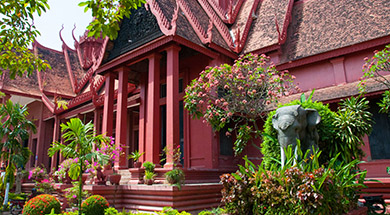
The National Museum of Cambodia is Cambodia's largest museum of cultural history and is the country's leading historical and archaeological museum. It is located in Chey Chumneas,[1] Phnom Penh.
The museum houses one of the world's largest collections of Khmer art, including sculptural, Khmer ceramics, bronzes, and ethnographic objects. Its collection includes over 14,000 items, from prehistoric times to periods before, during and after the Khmer Empire, which at its height stretched from Thailand, across present-day Cambodia, to southern Vietnam.

Choeung Ek is the site of a former orchard and mass grave of victims of the Khmer Rouge – killed between 1975 and 1979 – in Dangkao Section, Phnom Penh, Cambodia, about 17 kilometres (11 mi) south of the Phnom Penh city centre. It is the best-known of the sites known as The Killing Fields, where the Khmer Rouge regime executed over one million people between 1975 and 1979.
Mass graves containing 8,895 bodies were discovered at Choeung Ek after the fall of the Khmer Rouge regime. Many of the dead were former political prisoners who were kept by the Khmer Rouge in their Tuol Sleng detention center and in other Cambodian detention centers.
Today, Choeung Ek is a memorial, marked by a Buddhist stupa. The stupa has acrylic glass sides and is filled with more than 5,000 human skulls. Some of the lower levels are opened during the day so that the skulls can be seen directly. Many have been shattered or smashed in.
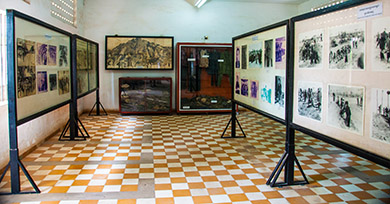
The Tuol Sleng Genocide Museum or simply Tuol Sleng, "Hill of the Poisonous Trees" or "Strychnine Hill") is a museum chronicling the Cambodian genocide. Located in Phnom Penh, the site is a former secondary school which was used as Security Prison 21 (S-21) by the Khmer Rouge regime from 1975 until its fall in 1979. From 1976 to 1979, an estimated 20,000 people were imprisoned at Tuol Sleng and it was one of between 150 and 196 torture and execution centers established by the Khmer Rouge. On 26 July 2010, the Extraordinary Chambers in the Courts of Cambodia convicted the prison's chief, Kang Kek Iew, for crimes against humanity and grave breaches of the 1949 Geneva Conventions. He died on 2 September 2020 while serving a life sentence.
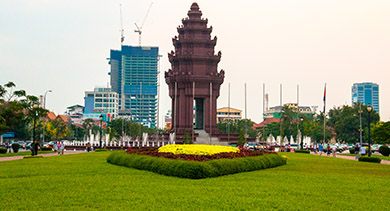
The Independence Monument in Phnom Penh, capital of Cambodia, was built in 1958 to memorialise Cambodia's independence from France in 1953. It stands on the intersection of Norodom Boulevard and Sihanouk Boulevard in the centre of the city. It is in the form of a lotus-shaped stupa, of the style seen at the Khmer temple at Banteay Srei and other Khmer historical sites. The Independence Monument was designed by the Cambodian architect Vann Molyvann, who was “personally selected and instructed” by Prince Norodom Sihanouk on how it should look like, combining “the religious and the secular.” It stands 37 metres tall.
During national celebrations, The Independence Monument is the center of activity. A ceremonial flame on the interior pedestal is often lit by a royal or high official on these occasions, and floral tributes line the stairs. Every year, The Independence Monument is visited by foreign tourists and locals alike. Behind the monument is the Norodom Sihanouk Memorial, constructed in 2013.
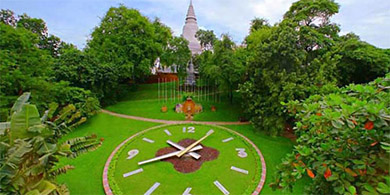
Wat Phnom is a Buddhist temple (wat) is a pagoda that symbolizes the name of Phnom Penh, a historical site in the record of Khmer national identity. Wat Phnom Doun Penh has a total height of 46 meters equal to the height of feet (150ft). The pagoda is named after grandmother "Doun Penh" who has the story of the discovery of the four statues: one Vishnu statue and four buddhas statue.
In 1372, a wealthy old lady named "Doun Penh" lived on a small hill near the bank of the confluence of the four rivers. One day, when it was raining, Doun Penh went down to the port to take a bath and saw a floating Koki tree in the river and she call the village to fished it from the water. She and the villagers took a piece of wood to scrape off the mud and in the hole of the Koki tree, there were four Buddha statues made of bronze and brass and one made of marble. Another statue was in the form of Vishnu with the hands holding a staff, a chain, a snail, and a lotus flower. Doun Penh ask the villagers to help retrieve the Koki tree and receive the four treasures. Later, Doun Penh assigned the villagers to build an artificial hill and build a small wooden temple on top of the hill to house the statue. She invited monks to pray for the statues and the monks named the hermitage "Wat Phnom" which is known to this day.
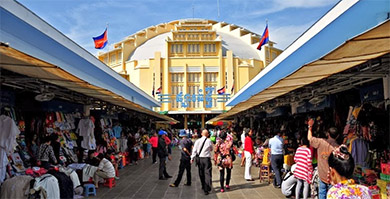
The Central Market is an Art Deco landmark of Phnom Penh, the capital of Cambodia. The bright yellow building completed in 1937 has a 26m high central dome, with four tall arch-roofed arms branching out diagonally across the block, creating vast hallways housing countless stalls and a variety of goods. Initially designed by city architect Jean Desbois, construction works were supervised by French architect Louis Chauchon. When it first opened in 1937, it was said to be the biggest market in Asia; today it still operates as a market.
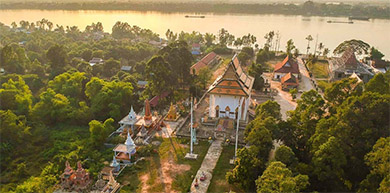
Koh dach, Kandal is a picturesque island located on the banks of Mekong River, on the upstream of Phnom Penh. Kandal is one of the provinces in Cambodia offering a vast range of sightseeing places and historical sites. Koh dach, Kandal is one of the popular tourist destinations in the province as well as in Cambodia. The entire area of Koh dach island covers 30 square kilometers of land lying on the shores of
Mekong River. The travelers, who want a break from the buys and hectic life, can land to this secluded and sleepy island. The tourists can reach the island within a minute from Phnom Penh by availing boats. The island is located on the National Road No. 6a in Kon Dach Commune.




















